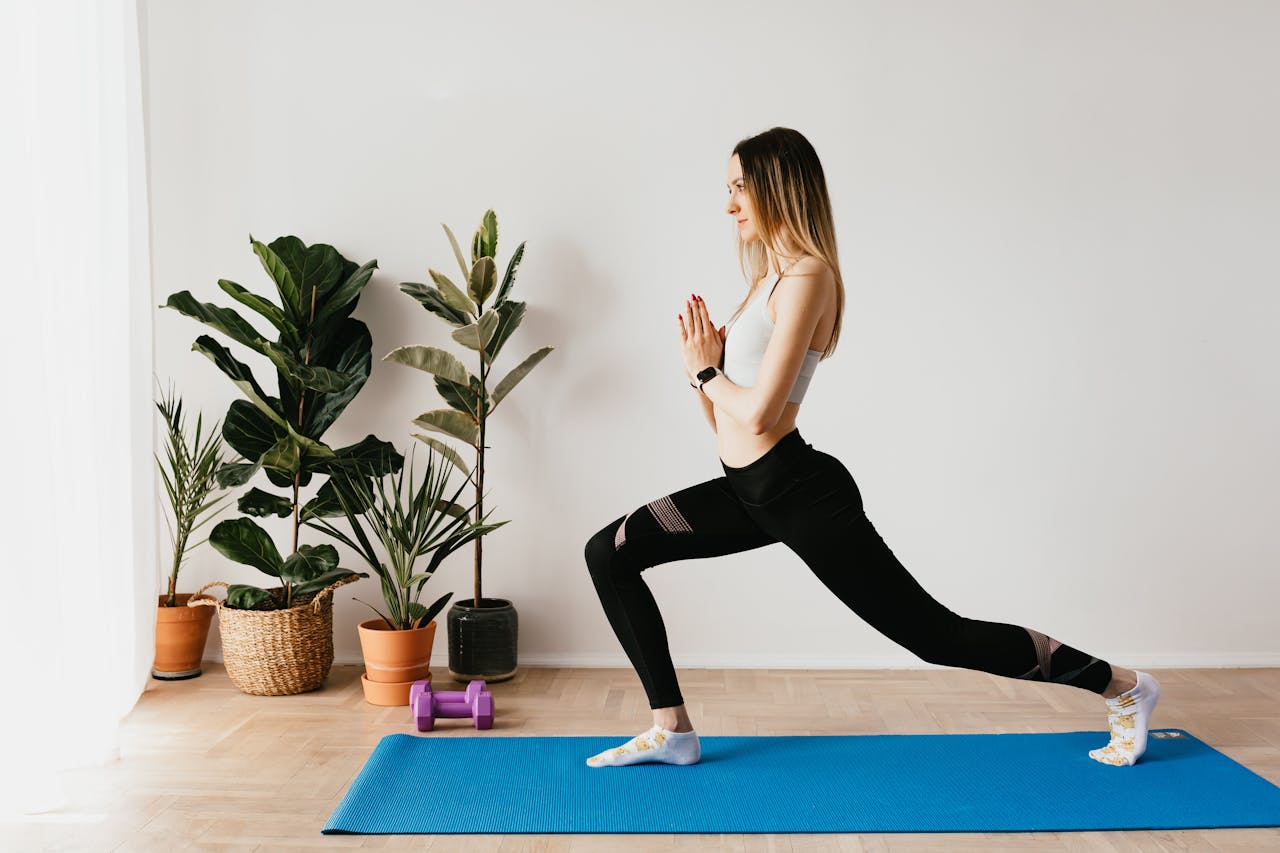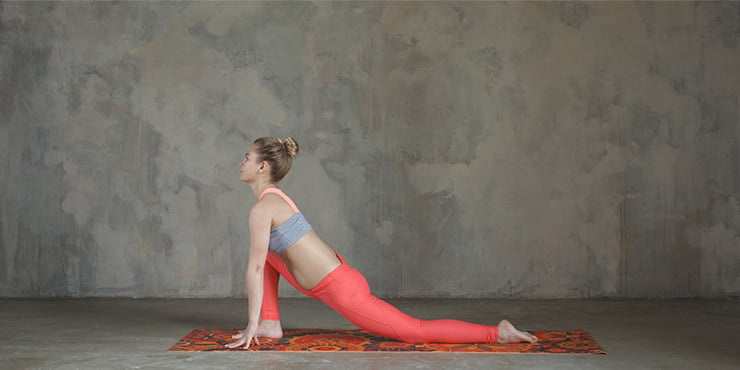
Table of Contents
Ashwa Sanchalanasana, also known as the equestrian pose, is a yoga posture commonly performed as part of the Sun Salutation sequence. The pose involves stepping one foot back into a lunge position while keeping the front knee bent and the hands on the ground. It helps to improve balance, flexibility, and strength in the legs and hips.
A Dynamic Stretching Pose
Ashwa Sanchalanasana, also known as equestrian pose, is a low lunge posture with both hands on the floor. In yoga practice, the equestrian pose, or Ashwa Sanchalanasana, is a balancing posture that teaches the practitioner how to align opposing forces to create stability.
Yoga teachers will use this yoga pose in Surya Namaskar or sun salutations as the fourth and ninth posture to transition from Uttanasana to Adho Mukha Svanasana (downward facing dog) or Phalakasana (plank pose). The equestrian pose is a key posture in modern yoga practice and is part of most yoga classes.
Ashwa Sanchalanasana Sanskrit Translation
The Sanskrit name of this pose breaks down into three elements:
- Ashwa = horse
- Sanchalana = stepping movement
- Asana = pose.
In English, it is called equestrian pose or horse riding pose. It could also be thought of as horse stepping pose, mimicking a horse as it ambulates.
What is Low Lunge Pose?
Anjaneyasana is a similar pose to Ashwa Sanchalanasana and goes in Surya Namaskar. Anjaneyasana is a lunging pose that keeps the hands off the ground.
When practicing Ashwa Sanchalanasana, practitioners can have their back knee resting on the ground with the top of the foot flat on the floor. If the knee is uncomfortable in this position, practitioners are encouraged to fold their yoga mat over or rest their knee on a folded towel, knee pad, or other cushioning.
A variation is lifting and straightening the back knee while keeping the top of the foot flat on the floor. One can also straighten the extended leg with the toes of the back foot tucked.
Modifications or Warm Ups
If yoga practitioners cannot perform a low lunge for whatever reason, one option for warming up to equestrian pose is to hug one knee to the chest while standing. A few preparatory poses and stretches can also help prepare the body.
People can try this balancing posture close to a wall or other support to hold on to balance if required. Work towards doing this with the standing knee straight.
Initially, one may find this more comfortable and easier to balance with the standing foot turned out. And while in low lunge, one should generally keep their knee pointing straight down. In this standing variation, one can experiment with different degrees of turnout. This can help improve hip flexibility and control, particularly if practitioners work at bracing their hips.
Benefits & Precautions
The equestrian pose has many mental and physical benefits that work together to improve practitioner wellbeing. The yoga pose activates, strengthens, and stretches many underutilized muscles by changing the placement of the body weight. Some of the benefits of regular practice include the following:
-
Strengthens the leg and hip muscles: Ashwa Sanchalanasanacan can strengthen the muscles at the front and back of the back leg to improve balance.
-
Increases flexibility: It assists in hip opening by stretching the hip extensors, hip flexors, deep core muscles, thighs, back muscles, and hamstrings.
-
Reduces stress: Equestrian pose creates mental clarity and improves emotional wellbeing.
-
Improves digestion: The posture stimulates abdominal organs to reduce indigestion. The abdominal organs on the back leg may also benefit since the psoas muscles are in a lengthened position.
-
Enhances breathing: Holding the posture with deep breaths strengthens the chest muscles to enhance lung capacity.
Ashwa Sanchalanasana also benefits the chakra energy system due to it’s close associations with the Manipura chakra, which is the third chakra located at the solar plexus. This chakra is linked to personal power, self-esteem, and confidence, and practicing this pose can help to balance and stimulate this energy center.
While equestrian pose has profound physical benefits, it is not for everyone. If someone has a neck injury, they should forego Ashwa Sanchalanasana, as the neck will have to support the weight of the head. Practitioners should also avoid this posture if they have a knee injury or ankle injury. Pregnant women should also avoid this posture as it increases abdominal pressure. Lastly, if one has any hip injuries, be aware that this pose can place a lot of stress on the hip of the front leg.
Equestrian Pose Alignment
To practice Ashwa Sanchalanasana equestrian pose perfectly and efficiently, there are a few things practitioners should keep in mind.
Front shin alignment
During Ashwa Sanchalanasana, the middle of the front foot should be positioned beneath the front of the knee so that the shin is nearly vertical. While sinking the hips deeper in this pose, one may have to adjust the front-back distance between the feet to maintain the upright position of the front shin.
Stretching both hips
Ashwa Sanchalanasana gives the hips a deep stretch. Rather than trying to relax suddenly, work at slowly relaxing. To make it easier to relax the muscles. Practitioners may find it helpful to brace the front foot, ankle, and knee muscles. Practitioners can do the same with the back foot, ankle, and knee, whether the knee is bent on the floor or lifted and straight.
Looking Forwards in Ashwa Sanchalanasana
If doing equestrian pose as part of a sun salute, practitioners should consider shifting their gaze forward. One should avoid this if they have neck pain or neck problems. If the practitioners keep their eyeline down, as the spine lengthens, they can lift their head slowly after making their neck feel long.
Additionally, one may find it more comfortable to look forwards if they begin by protracting their shoulder blades and then rotating their upper arms so their elbows point back. From there, reach the chest forwards and lengthen the neck by drawing the ear holes forwards. If it feels comfortable, slowly lift the head, bending the neck back to look forward.
Another option is to keep the back of the neck feeling long and look straight down.
If the practitioner lifts the head, they may want to focus on the third eye chakra. If looking straight down, one may find it feels right to focus on their crown chakra.
Should the foot be inside the hands or outside?
When preparing to step back into Ashwa Sanchalanasana from Uttanasana or standing forward bend, practitioners can have their hands on the floor to the outside of their feet.
Stepping one foot back into the low lunge, practitioners can then leave their foot to the inside of the same side hand. Likewise, when stepping forward from downward dog or plank into a low lunge, practitioners can do the same thing, step the back foot forward so that both feet end up inside the hands.
If holding Ashwa Sanchalanasana, practitioners can reposition their front leg hand inside the same side foot by transferring the front foot outwards. There is also room to adjust the knee, by moving it slightly inwards or outwards as required.
Learning Ashwa Sanchalanasana as Part of Surya Namaskar

When performing a low lunge as part of a sun salutation, begin by stepping one leg back into the low lunge position, keeping both hands on the floor. Practitioners may have to bend their knees to get their hands on the floor. Those who can touch their hands to the floor with a stretched leg may have to bend their legs to step one leg back.
People should take their time reaching the leg back. One may find that they can feel the muscles at the back of the leg for support. When entering the low lunge, try to maintain this feeling of lift, which may be easier with the back knee straight. Keep lifting the leg while simultaneously sinking the hips.
When doing the second half of Surya Namaskar, practitioners return to standing and step forward into a low lunge. Here, one will notice the muscles activating as they bring the working leg forward into Ashwa Sanchalanasana.
Focusing on the front leg in a low lunge, one can try to find this feeling with their foot on the floor and imagine lifting the knee. This action may help the hips to sink down.
How to create stability in Ashwa Sanchalanasana?
As with most balancing postures, one of the challenges in Ashwa Sanchalanasana is creating stability. Stability occurs when they activate their legs, as previously described.
Activate the front foot
Begin with the front foot outside the hands, engaging the foot, heel, and ankle. One way to do this is to press the forefoot down into the floor without allowing the heel to lift. Simultaneously work at preventing the hips from lifting. One may notice that the more they press down, the greater the sensation of activation, both in the foot and the thigh.
Once one has secured this activation, one may need to adjust or vary it. Practitioners can do this by moving the front knee slightly inwards or outwards. If the practitioner has tried shin rotations relative to the foot while standing in tadasana (mountain pose) or even in Urdhva Hastasana, they can try the same thing here. Attempt rotating the shin outwards (relative to the foot) so that the lift of the inner arch of the front foot increases or rotating the shin inwards so that the lift of the arch decreases.
Practitioners may find that their knee moves outwards with external shin rotation and inwards with internal shin rotation. Use the most comfortable position for the foot, ankle, knee, and hip.
Activating the back foot
With the top of the back foot flat on the floor, actively press the foot into the floor. At the same time, avoid allowing the knee and hip to lift. For extra stability, try pressing the big toe of the front and back foot down into the floor.
Activating the back foot with back knee straight in equestrian pose
If practitioners perform Ashwa Sanchalanasana with the back leg straight and toes tucked under, try to stiffen the back foot and ankle.
If one is doing equestrian pose with the knee of the back leg lifted and the top of the foot flat on the floor, try to press the toes down. Make sure that the back knee is pointing down, and brace it. This will activate the leg muscles and help strengthen them at the same.
The Transitions of Equestrian Pose
Moving from Low Lunge to Plank
Practitioners can move from low lunge equestrian pose to plank as part of Surya Namaskar or modern yoga practice. In this case, one will want to create stability in their arms before stepping the front leg back.
-
Keep the neck long by drawing the ears forward and up, away from the shoulders.
-
Work at spreading the shoulder blades. The hands on the ground will help the chest move up and away from the floor.
-
They can try the same with their elbows if the back knee feels strong while straightening it.
To move from low lunge to plank, one can shift their body to the back leg side. So if the right foot is back, move the body to the right. This places more pressure on one’s right hand, so ensure that the shoulder is still protracting and the elbow strong.
Moving from plank to low lunge
One can follow a similar procedure when moving from plank to low lunge pose. If the practitioner intends on pulling their right foot forwards, stretch the left knee and shift to the left. Lift the right hand, and if needed, use the right hand to help pull the right leg forwards.
Moving into Ashwa Sanchalanasana from Kneeling
A commonly described method for moving into Ashwa Sanchalanasana is to move into it from a kneeling position. Kneeling can be a nice counterpose or resting pose for Ashwa Sanchalanasana and, more particularly, for the more upright low lunge Anjaneyasana, giving the legs a chance to rest.
To move into a lunge from kneeling, lift the hips, step the left foot firmly onto the floor, and finish with the thigh parallel to the floor. With hands on the floor, slide the right leg back, allowing the hips to sink with the upper body. One may have to reposition their hands as their leg slides further back. As the hips sink down, the front thigh will no longer be parallel to the floor.
References
https://www.yogajournal.com/poses/low-lunge
https://yogainternational.com/article/view/ashwa-sanchalanasana-equestrian-pose
https://www.gaia.com/article/low-lunge-ashwa-sanchalanasana
https://www.verywellfit.com/equestrian-pose-ashwa-sanchalanasana-3567050
https://www.yogapedia.com/definition/5361/ashwa-sanchalanasana
https://www.doyouyoga.com/ashwa-sanchalanasana-equestrian-pose/
https://theyogainstitute.org/ashwa-sanchalanasana/
https://www.yogabasics.com/asana/low-lunge/
https://www.ekamyogashala.com/ashwa-sanchalanasana-equestrian-pose-steps-benefits-precautions
Disclaimer
The contents of this article are provided for informational purposes only and are not intended to substitute for professional medical advice, diagnosis, or treatment. It is always recommended to consult with a qualified healthcare provider before making any health-related changes or if you have any questions or concerns about your health. Anahana is not liable for any errors, omissions, or consequences that may occur from using the information provided.

By: Anahana
The Anahana team of researchers, writers, topic experts, and computer scientists come together worldwide to create educational and practical wellbeing articles, courses, and technology. Experienced professionals in mental and physical health, meditation, yoga, pilates, and many other fields collaborate to make complex topics easy to understand.
